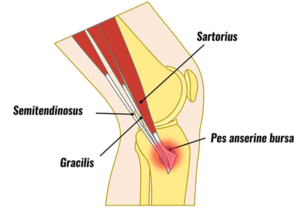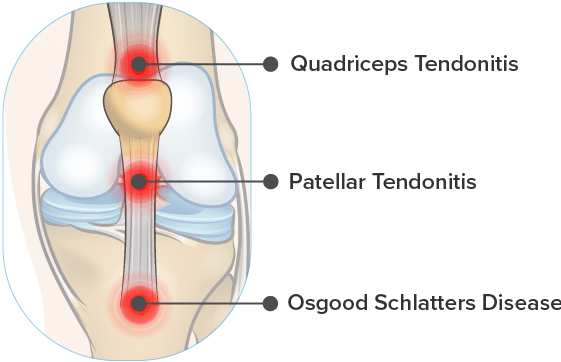- Pes Anserine Tendinitis
- Quadriceps Tendonitis
- Pre-patellar and Infra-Patellar Bursitis
- Patellar Tendonitis

The pes anserine is a group of three tendons (sartorius, gracilis and semitendinosus) that attach on the inside portion of the shin bone below the knee joint. Pes anserine tendinitis is inflammation of the tendons and surrounding sheaths.
What are the causes?
Pes anserine tendinitis results from overuse or changes in the way someone walks because of another injury. Direct trauma to the area may also cause pes tendinitis.
What are the symptoms?
Pes anserine tendinitis causes pain at the insertion of the tendons on the inside of the tibia. The area is painful and may become swollen.
How is it diagnosed?
Dr. Chandrasekaran will perform a thorough history and physical exam, which typically includes X-rays. Typically there is no bone abnormality and the area of tendon insertion is painful with pressure. Dr. Chandrasekaran will evaluate the motion and strength of the muscles around the knee. Some weakness and pain may be noted. X-rays are usually normal. MRI may be ordered if the diagnosis is unclear.
How it is treated?

Non-Operative
Non-operative management of pes anserine tendinitis is the only treatment. Dr. Chandrasekaran may prescribe anti-inflammatory medication, physical therapy, cryotherapy and activity modification to avoid painful activities. Therapeutic high frequency ultrasound administered by your physical therapist has been used successfully to treat this condition. Dr. Chandrasekaran may offer you an injection.

The quadriceps tendon attaches the patella (aka-kneecap) to the quadriceps muscle on the front of the thigh. It is responsible for transmitting force from the quadriceps muscle, resulting in the ability to extend the knee. Quadriceps tendinitis is inflammation of the tendon and surrounding sheath. Quadriceps tendinitis is less common than patellar tendonitis.
What are the causes?
Quadriceps tendinitis results from overuse or from a direct blow to the front of the knee. Quadriceps Tendinitis frequently occurs in athletes who play sports such as basketball and volleyball because of the repetitive jumping involved.
What are the symptoms?
Quadriceps tendinitis causes pain in the front of the knee just above the kneecap. The pain is activity related and is commonly associated with squatting, running or using stairs. There is sometimes swelling in the joint.
How is it diagnosed?
Dr. Chandrasekaran will perform a thorough history and physical exam, which typically includes X-rays. Typically there is no bone abnormality and the area directly above the patella may be painful with pressure. Dr. Chandrasekaran will evaluate the motion and strength of the muscles around the knee. Some weakness and pain may be noted with resisted knee extension. X-rays are usually normal unless the inflammation is chronic, resulting in calcium formation within the tendon. MRI may be ordered if surgery is possible in the future.
How it is treated?

Non-Operative
Non-operative management of quadriceps tendinitis is first-line of treatment. Dr. Chandrasekaran may prescribe anti-inflammatory medication, physical therapy, cryotherapy and activity modification to avoid painful activities. Therapeutic high frequency ultrasound administered by your physical therapist has been used successfully to treat this condition. Dr. Chandrasekaran may offer you an injection.

Operative
Operative treatment for quadriceps tendinitis is seldom indicated, as most patients will respond to non-operative treatment. If non-operative treatment fails and operation becomes necessary, the surgeon makes several longitudinal splits in the tendon and drills into the kneecap to encourage bleeding from the bone. The drill holes allows bone marrow to leak into the lesion bringing with it blood cells that are capable of healing the damaged tendon.

The pre-patella and infra-patellar bursa are thin, protective layers of tissue found between the structures in the front of the knee (pre-patella=patella, infra-patella=patella tendon) and the skin. Bursa acts as a cushion to protect the patella from trauma. Bursa can become inflamed and thickened, as well as infected, causing pain and requiring treatment.
What are the causes?
Pre-patellar/infra-patellar bursitis can occur from trauma to the anterior aspect of the knee, or from chronic kneeling. Another term for pre-patellar bursitis is “housemaid's knee”, as it is commonly seen in people who spend a lot of time kneeling and squatting.
What are the symptoms?
Pre-patella and infra-patella bursitis cause pain and swelling in the front of the knee. If it becomes infected, the patient may complain of fevers, drainage from the front of the knee, redness and tenderness to the touch.
How is it diagnosed?
Dr. Chandrasekaran will perform a thorough history and physical exam, which typically includes X-rays. Moderate swelling in the front of the knee with preserved motion and strength is usually diagnostic. X-rays will be negative for bone damage but may show soft-tissue/bursal swelling.
How it is treated?

Non-Operative
Non-operative treatment of bursitis is usually the first line of treatment. Dr. Chandrasekaran may recommend anti-inflammatory medicine, cryotherapy and activity modification to help reduce the pain and inflammation. Dr. Chandrasekaran may offer to “drain” the bursa, followed by anti-inflammatory medication and compression dressing to prevent the swelling from returning. For those with occupations that require kneeling, protective knee pads are suggested to prevent recurrence.

Operative
If non-operative treatment fails to relieve the pain and inflammation, Dr. Chandrasekaran may suggest surgery. The bursa can be removed through a small incision in the front of the knee. Physical therapy to restore full function is initiated at Dr. Chandrasekaran’s discretion.

The patellar tendon attaches the patella (aka-kneecap) to the tibia (shin bone). It is responsible for completing the transmission of force from the quadriceps muscle, resulting in the ability to extend the knee. Patellar tendinitis is inflammation of the tendon and surrounding sheath.
What are the causes?
Patellar tendinitis results from overuse or from a direct blow to the front of the knee. Patellar tendinitis, also known as 'jumper's knee', frequently occurs in athletes who play sports such as basketball and volleyball because of the repetitive jumping involved.
What are the symptoms?
Patellar tendinitis causes pain in the front of the knee just below the kneecap. The pain is activity related and is commonly associated with squatting, running or using stairs. There is sometimes swelling in the joint.
How is it diagnosed?
Dr. Chandrasekaran will perform a thorough history and physical exam, which typically includes X-rays. Typically there is no bone abnormality and the area directly below the patella may be painful with pressure. Dr. Chandrasekaran will evaluate the motion and strength of the muscles around the knee. Some weakness and pain may be noted with resisted knee extension. X-rays are usually normal unless the inflammation is chronic, resulting in calcium formation within the tendon. MRI may be ordered if surgery is possible in the future.
How it is treated?

Non-Operative
Non-operative management of patellar tendinitis is first-line of treatment. Dr. Chandrasekaran may prescribe anti-inflammatory medication, physical therapy, cryotherapy and activity modification to avoid painful activities. Therapeutic high frequency ultrasound administered by your physical therapist has been used successfully to treat this condition. Dr. Chandrasekaran may offer you an injection. A strap worn over the patella tendon may reduce pain by taking stress off of the tendon's attachment site.

Operative
Operative treatment for patellar tendinitis is seldom indicated, as most patients will respond to non-operative treatment. If non-operative treatment fails and operation becomes necessary, the surgeon makes several longitudinal splits in the tendon and drills into the kneecap to encourage bleeding from the bone. The drill holes allows bone marrow to leak into the lesion bringing with it blood cells that are capable of healing the damaged tendon.
